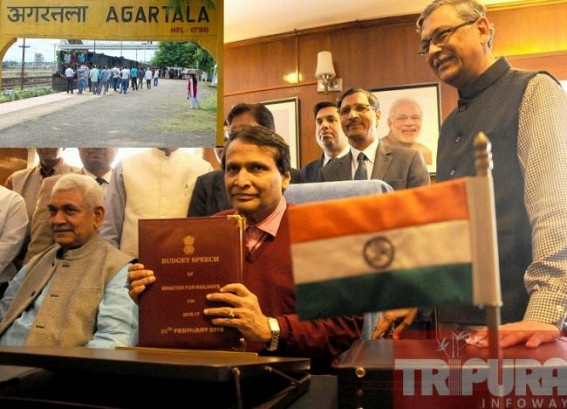TIWN

AGARTALA / NEW DELHI, Feb 25 (TIWN): Will Railway Minister Suresh Prabhu increase passenger fares and freight tariff? That's the question that pops up as he presents his ministry's annual budget for the next fiscal amid shrinking margins, that is leaving little room for modernisation, upgrade and safety.In the previous budget, the minister spared passengers from a fare hike, but freight rates were increased by 2.1 percent to 10 percent, even on commodities such as grain, pulses, urea and coal. And in July 2014, the hikes amounted to 15 percent in passenger fares and 6.5 percent in freight. The 437-km Lumding-Silchar and Badarpur-Agartala gauge conversion work was sanctioned in 1996. It was declared a national project in 2004, thereby ensuring uninterrupted funding from the central government's general budget. After Modi Govt came to power in 2014, Tripura railway projects gained speed after that turbulent period of insurgency from 2006 to 2009. In the first phase, the 210-km Lumding-Silchar gauge conversion project was completed early last year.
In the second phase, the 227-km Badarpur-Agartala gauge conversion was undertaken.
It was scheduled to be completed in March but was completed three months earlier. Narendra Modi led Central Govt and Railway Minister Suresh Prabhu’s dynamic efforts expedited BG Railway progress in Tripura.
Industry chambers have advocated a hike in passenger fares this time.
"There is lack of political will to raise passenger fares, though the reluctance is not shared by passengers who will be willing to pay more if it is accompanied by better services like timely arrival of trains, cleanliness at stations, safety and improvement in food," Assocham said.
Introduction of new trains without much capacity addition in terms of new lines has become a norm. The issue that Prabhu will have to tackle is to improve the operating ratio that spells out how much of the revenue generated is spent on day-to-day operations.
In the last budget, the minister had targeted to bring the operating ratio down to 88.5 percent, or the lowest in nine years, from an unsustainable level of 93.6 percent in 2013-14 and 91.8 percent for 2014-15. But globally, a 75-80 percent or lower is seen as a healthy benchmark.
The network length of Indian Railways has also not expanded in the requisite manner. It has increased just 0.06 times since 1989-90, but passenger and freight traffic has increased 3.3 times and 2.2 times, respectively. The average train speed of 25 km per hour for freight and 70 km per hour for passengers is also among the lowest globally.
The railways will also have to contend with a 40 percent (Rs.320 billion) jump in wages. Experts have, accordingly, called for some newer approaches to enable the Indian Railways to raise money and fund its development.
"The sheer number of land parcels held by Indian Railways across the country makes this entity an important stakeholder in transit-oriented development," said Anuj Puri, chairman of JLL India, referring to mixed-use residential and commercial area with access to public transport.
"This budget we expect the railway minister to look at monetising railways' land parcels in urban areas through transit-oriented development -- in order to boost cities' liveability quotient and modernisation of their skylines," Puri said.
Some of the other issues that stakeholders expect Prabhu to address include introduction of more wagons, development of physical infrastructure, fine-tuning the public-private partnership model, improvement of passenger amenities and making rail transportation competitive.
India boasts one of the oldest and the largest railroad networks in the world, ferrying some 23 million people, or a population the size of Australia, as also 2.65 million tonnes of goods on its coaches, each day.
It serves from 7,172 stations via 12,617 passenger and 7,421 freight trains on a track network spanning Baramulla in the Himalayan foothills of Kashmir to the southern tip of Kanyakumari in Tamil Nadu, and from Naharlagun in Arunachal Pradesh to the port town of Okha in Gujarat.
A day after an indefinite rail blockade demanding statehood or union territory status for Cooch Behar in northern West Bengal was lifted, train movement on the Northeast Frontier Railway (NFR) was partially restored on Wednesday.
Owing to the rail blockades by the Greater Cooch Behar People's Association (GCPA) in Bengal as well as by the members of the Jat community in Haryana, the NFR had cancelled/diverted a host of trains.
According to the NFR, trains services over the New Jalpaiguri - New Coochbehar - New Bongaigaon section resumed during the day with at least 33 trains including the Kanchanjunga Express, Capital Express and Kamrup Express restored.
"However, complete normalcy of the train services will take time," said an NFR spokesperson.
- Protest in Tripura against Tripura Education Board's Huge Fee Hikes
- Patient Party Alleged 'Punishment Referral' Punishment for Speaking Out at IGM Hospital
- Pakistani Woman Held in Sabroom, Probe Underway
- 150 Mobile Phones Recovered in Sonamura Border Operation
- ABVP Demanded Every Year 'Little' fee hikes for TBSE Exams



